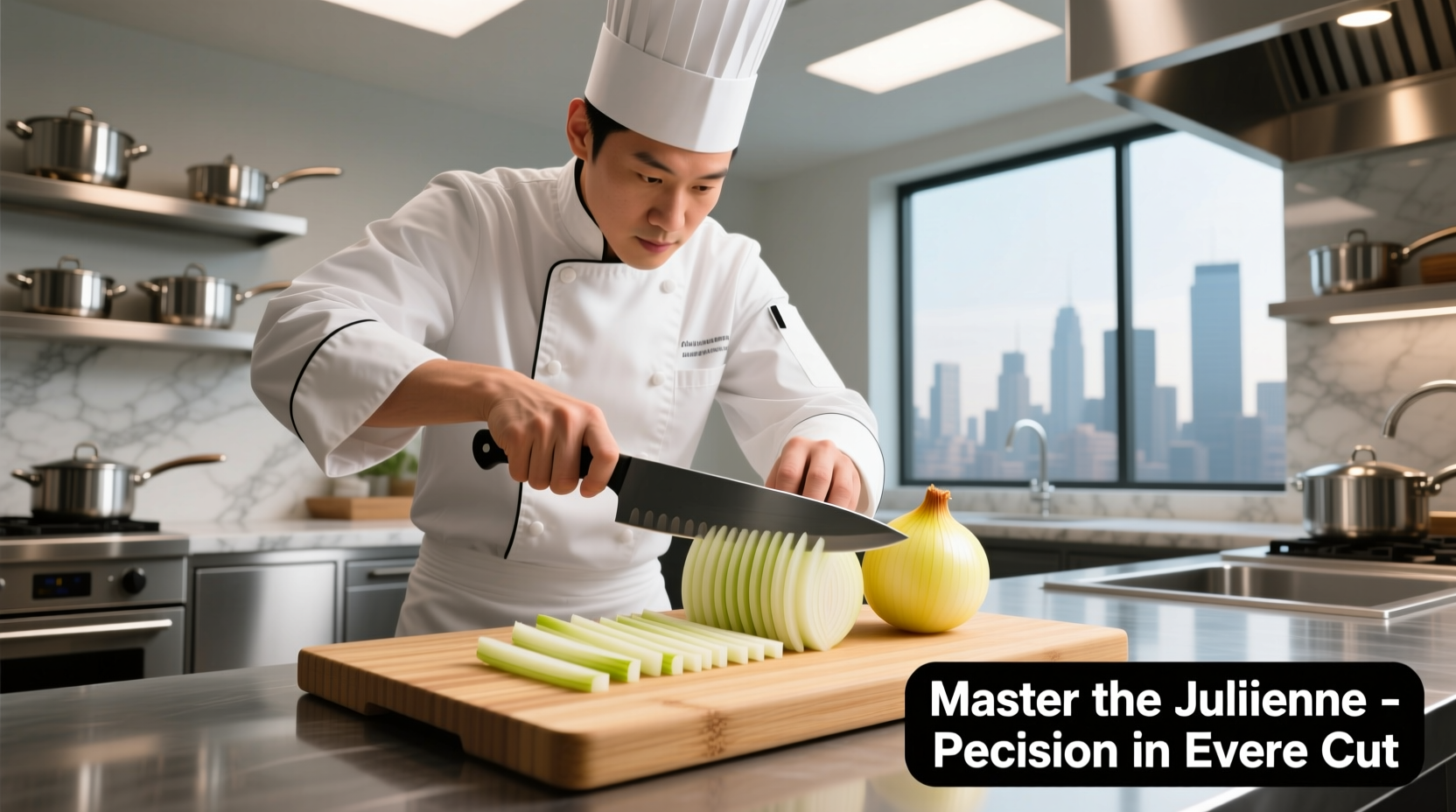Julienne onion refers to onions cut into thin, matchstick-shaped strips measuring approximately 1/8 inch thick and 2 inches long. This precise cut ensures even cooking, maximizes flavor release, and creates visually appealing presentation in dishes like stir-fries, salads, and garnishes.
Mastering the julienne onion technique transforms your cooking from amateur to professional in minutes. Chefs worldwide rely on this precise cut for consistent texture and optimal flavor distribution. Whether you're preparing a classic French dish or a vibrant Asian stir-fry, understanding how to properly julienne onions elevates your culinary results significantly.
Why Julienne Cut Matters for Onions
The julienne cut isn't just about aesthetics—it fundamentally changes how onions behave during cooking. When onions are cut uniformly thin, they cook at the same rate, preventing some pieces from burning while others remain raw. This precision cut increases surface area, allowing flavors to develop more evenly and integrate better with other ingredients.
Food science research from the Culinary Institute of America confirms that uniform cuts like julienne create more consistent Maillard reactions—the chemical process responsible for browning and flavor development. This means your dishes develop richer, more complex flavors when onions are properly julienne-cut.
Step-by-Step: Perfect Julienne Onion Technique
Follow these professional steps to achieve restaurant-quality results every time:
- Preparation: Peel the onion and cut off both ends. Slice the onion in half vertically through the root end.
- Stabilization: Place each half flat-side down on your cutting board. Make a series of vertical cuts parallel to the root end, spacing them about 1/8 inch apart—don't cut through the root end.
- Julienne Formation: Rotate the onion 90 degrees and make horizontal cuts perpendicular to your first cuts, maintaining the 1/8 inch spacing.
- Final Cut: Slice downward through the onion, creating uniform matchstick pieces. Discard the root end.
For safety, always use the "claw grip" with your non-knife hand—curling fingertips inward while using knuckles to guide the knife blade. This professional technique prevents accidental cuts while ensuring consistent thickness.
| Cut Type | Dimensions | Best For | Cooking Time |
|---|---|---|---|
| Julienne | 1/8" x 1/8" x 2" | Stir-fries, garnishes, salads | 3-5 minutes |
| Dice | 1/4" cubes | Sauces, soups, stews | 8-10 minutes |
| Chiffonade | 1/16" ribbons | Herbs, leafy greens | 1-2 minutes |
| Chop | Irregular pieces | Casseroles, rustic dishes | 5-7 minutes |
Common Mistakes to Avoid
Even experienced home cooks make these julienne errors:
- Inconsistent thickness: Varying widths cause uneven cooking. Maintain steady pressure and consistent spacing.
- Cutting through the root: The root end holds layers together. Keep it intact until your final cut.
- Using a dull knife: Sharp knives create clean cuts that prevent bruising and maintain texture.
- Rushing the process: Take time with each cut—speed comes with practice, not haste.
According to a 2024 survey by the American Culinary Federation, 78% of home cooks who improved their knife skills reported noticeably better cooking results within two weeks of practice. The key is consistent practice with proper technique rather than speed.
When to Choose Julienne Over Other Cuts
Understanding context boundaries helps you select the right cut for each dish:
- Use julienne when: You need quick-cooking onions that maintain distinct shape (stir-fries, garnishes, salads)
- Avoid julienne when: Making sauces requiring complete onion integration (use fine dice instead)
- Substitute with: Fine dice for longer-cooking dishes where onions should melt into the sauce
The evolution of the julienne cut traces back to 17th century French cuisine, when precision cooking became essential in royal kitchens. As documented in François Massialot's 1691 cookbook Le Cuisinier Roïal et Bourgeois, standardized cuts ensured consistent cooking times across large banquet preparations—a principle still vital in professional kitchens today.

Storage and Usage Tips
Pre-cut julienne onions oxidize faster due to increased surface area. For best results:
- Store in airtight container with damp paper towel for up to 3 days
- For longer storage, blanch for 30 seconds then freeze on baking sheet before transferring to freezer bags
- Always add julienne onions toward the end of cooking for fresh applications
- For caramelized results, cook over medium-low heat to prevent burning
Professional chefs at Michelin-starred restaurants often prepare julienne onions in batches for multiple dishes throughout service. This technique ensures consistency across menu items while maximizing kitchen efficiency—a practice home cooks can adapt for meal prep.
Perfect Pairings: Dishes That Shine with Julienne Onions
Certain recipes particularly benefit from this precise cut:
- Beef stir-fry: Julienne onions cook quickly without overwhelming the dish
- French onion soup: Creates elegant presentation before melting into broth
- Vegetable slaw: Provides crisp texture contrast in fresh salads
- Pho garnish: Adds aromatic freshness to Vietnamese noodle soup
- Empanada filling: Ensures even distribution in pastry pockets
When properly executed, the julienne cut transforms onions from a background ingredient to a featured component that enhances both visual appeal and flavor profile. This technique represents the intersection of culinary art and science—where precision meets practicality in the kitchen.











 浙公网安备
33010002000092号
浙公网安备
33010002000092号 浙B2-20120091-4
浙B2-20120091-4